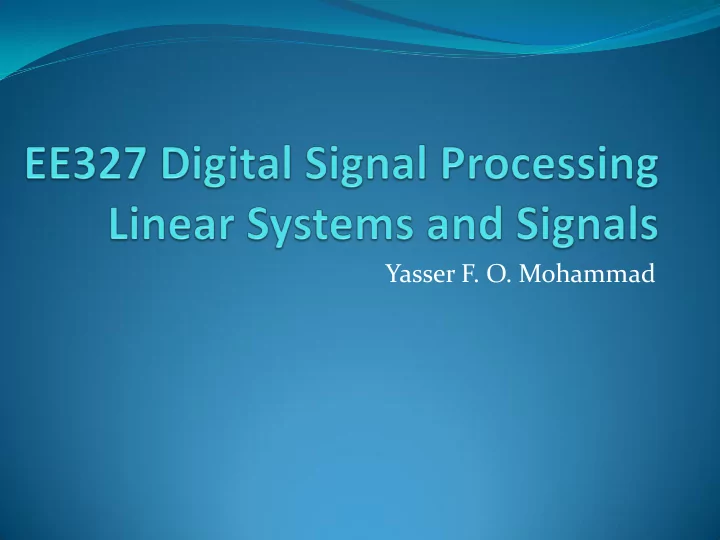

Yasser F. O. Mohammad
REMINDER 1: ADC
REMINDER 2: Sampling Our goal is to be able to reconstruct the analog signals completely from the digitized version (ignoring quantization). Proper sampling aliasing
REMINDER 3: Nyquist Frequency Half the sampling rate The maximum frequency representable in the discrete signal without aliasing f f s n 2
REMINDER 4: Aliasing Aliasing causes information loss about both high and low frequencies Aliasing causes a phase shift of π or zero as follows
REMINDER 5: Complete ADC/DAC system SELF TEST: Why do we need an antialiasing filter even if we are not interested in signals over the Nyquest frequency?
Let is play a game What is in the box Elephant Linear System Nonlinear System Ask me
Signal and System Signal Description of how a quantity(s) is varying with some parameter(s) System Any process that produces an output signal in response to an input signal System Input Signal Output Signal (Transfer function)
Types of Systems
Linear Systems Linear = Homogeneous+Additive Homogeneity If X[n] Y[n] then k X[n] k Y[n] Additive If X1[n] Y1[n] and X2[n] Y2[n] then X1[n]+X2[n] Y1[n]+Y2[n] Most DSP linear systems are also shift invariant (LTI)
Shift Invariance
Static Linearity How the system responses to nonvarying input (DC)? If it is linear Y= a X and a is a constant Linear System Static Linearity but Static Linearity Linear System
Memoryless systems The output depends only on instantaneous input not the history
How to prove Linearity (until now) Homogeneous + Additive = Linear Static Linearity + Memoryless Linear Linear Static Linearity
Sinusoidal Fidelity Linear system sinusoidal output for sinusoidal input Sinusoidal Fidelity Linear System (e.g. phase Lock Loop) This is why we can work with AC circuits using only two numbers (amplitude and phase) This is why Fourier Analysis is important This is partially why Linear Systems are important This is why you cannot see DSP without sin
Properties of Linearity- Commutative
Properties of Linearity – Superposition
Properties of Linearity – Multiple inputs and/or outputs Linear iff it can be decomposed into linear subsystems connected with only additions
Synthesis and Decomposition Synthesis Combine signals to produce complex ones Decomposition Decompose complex signals into simpler ones
Fundamental Concept of DSP
Common Decompositions Impulse Decomposition 1. Step Decomposition 2. Even/Odd Decomposition 3. Interlaced Decomposition 4. Fourier Decomposision 5.
Impulse and Step Decompositions
Even/Odd and Interlaced FFT
Fourier Decomposition Why sinusoidal? Periodic Time Domain Discrete Frequency Domain Discrete Time Domain Periodic Frequency Domain Periodicity Periodic aperiodic continuous Fourier Series Fourier Transform Continuity Aperiodic Spectrum Aperiodic Spectrum Discrete Spectrum Continuous Spectrum discrete Discrete Fourier Transform Discrete Fourier Transform Periodic Spectrum Periodic Spectrum Discrete Spectrum Continuous Spectrum
What if it was not linear? First (and usually last) option Assume it is linear If nonlinearity is small it will work (some times even if it is large!!!!) Keep it small Keep it short Linearize it E.g. take the log to convert * into +
Recommend
More recommend